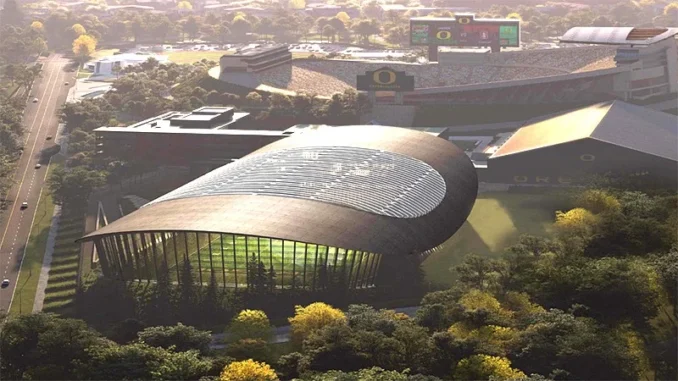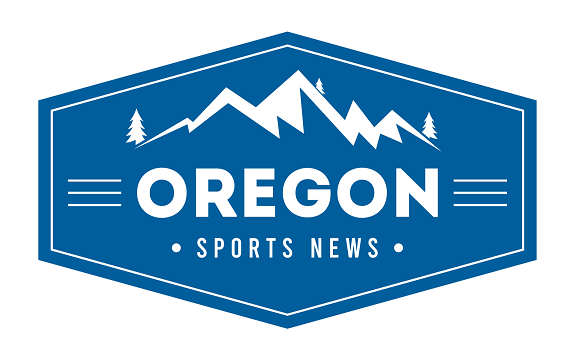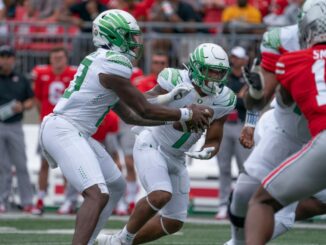
When Oregon football unveiled the phrase “2.MO” at the groundbreaking of its new state-of-the-art facility, it wasn’t just a clever branding slogan. It was a declaration of intent.
For decades, the Ducks have been known for innovation—flashy uniforms, eye-catching facilities, and a willingness to push college football’s culture forward. But their move into the Big Ten has forced them to focus less on aesthetics and more on sustainability. The program’s first season in the league was an introduction. This second season demands an identity that can travel—and “2.MO” is designed to provide exactly that.
From Flash to Function
Oregon’s Hatfield-Dowlin Complex and Moshofsky Center once set the national standard for facilities, proof of Phil Knight’s unmatched backing. But this latest project is less about shock value and more about intent.
The indoor practice facility, now under construction next to Autzen Stadium, will feature a full-length field with modern turf, expanded strength and conditioning space, and advanced recovery technology. In a league where November games in Madison and Ann Arbor punish teams unprepared for weather and attrition, “2.MO” ensures the Ducks can train year-round without interruption.
This building is not for headlines, but for habits. Every rep, every meeting, every recovery session will be backed by infrastructure that shortens recovery windows, maximizes repetitions, and integrates sports science into the daily routine.
Infrastructure With Intent
The Big Ten rewards depth and durability as much as speed. Oregon’s upgrades—expanded practice space, tech-driven meeting rooms, recovery-focused layouts—are designed to eliminate wasted time and streamline preparation.
Where earlier projects emphasized “wow factor,” this facility emphasizes efficiency and longevity. From film study to weight-room flow, “2.MO” integrates seamlessly with existing operations to give coaches, analysts, and players fewer friction points in their daily grind.
The goal is straightforward: to reduce installations from a week to a matter of days. Practice plans can be layered without weather disruptions. By design, the building itself reinforces the message: your body will be prepared, your mind will be prepared, nothing about the Big Ten will surprise you.
Why Oregon Needs “2.MO”
This is not about keeping up appearances. In the Big Ten, programs like Michigan, Ohio State, and Penn State already boast expansive indoor facilities that double as recruiting showcases. To compete, Oregon must demonstrate the same commitment.
The Ducks’ rainy climate only adds urgency. With “2.MO,” there’s no more losing ground to weather or travel. For recruits and transfers, the pitch is clear: Oregon offers a development ecosystem that rivals any in the country.
And it’s not just recruiting—it’s retention. In today’s transfer-heavy landscape, keeping players engaged is as critical as attracting them. A facility that invests in player growth, recovery, and preparation sends a powerful message: there’s a plan for you here, year after year.
Practice and Process
“2.MO” also redefines how Oregon practices. The Ducks know conference wins aren’t earned on Saturdays alone—they’re forged in Tuesday and Wednesday sessions.
Under the new model, sports science dictates rep distribution to prevent overload. Position-specific drills are mapped with precision. Situational work—red zone, third-and-long, two-minute execution—is rehearsed under conditions that mimic tempo and fatigue. Indoors, those sessions can now continue uninterrupted regardless of the weather.
The results show up not in theory, but on the field: fresher rotations in the fourth quarter, sharper execution in late-game installs, fewer breakdowns when the stakes are highest.
The Recruiting Pitch
For Oregon, “2.MO” is as much a message as it is a building. In recruiting battles, the Ducks aren’t just selling uniforms or NIL dollars—they’re selling development.
The promise is straightforward: come to Oregon and train in an NFL-style environment designed for the Big Ten stage. Every detail, from advanced film study to recovery science, becomes part of the sell.
That same environment helps keep rosters intact. Athletes see tangible progress year over year, not just in snaps but in skills. That kind of buy-in is invaluable in a sport where continuity is rare.
Foundation for the Future
Ultimately, Oregon’s new facility is not just concrete and turf—it’s the Ducks’ operating system for their Big Ten era. It represents a cultural shift from flash to function, from chasing headlines to sustaining habits.
The Ducks have always been innovators. But this era demands durability. By investing in “2.MO” now, Oregon isn’t just catching up—it’s laying the foundation for a decade of sustained national relevance.
The bottom line: “2.MO” is more than a building. It’s Oregon’s blueprint for thriving, not just surviving, in its new league.



